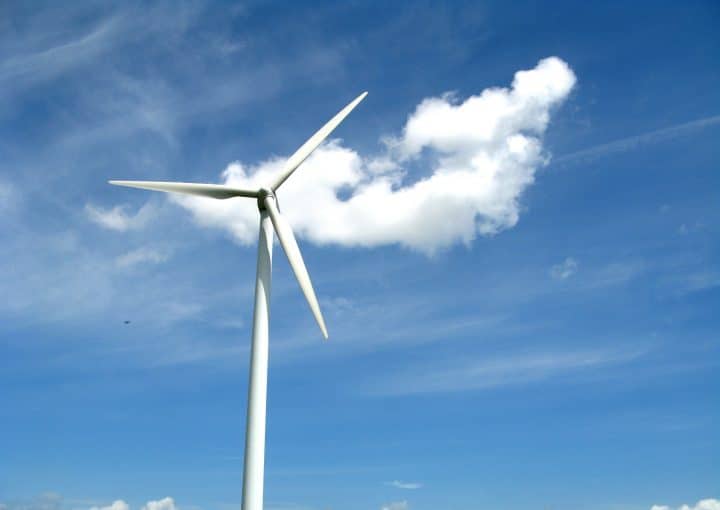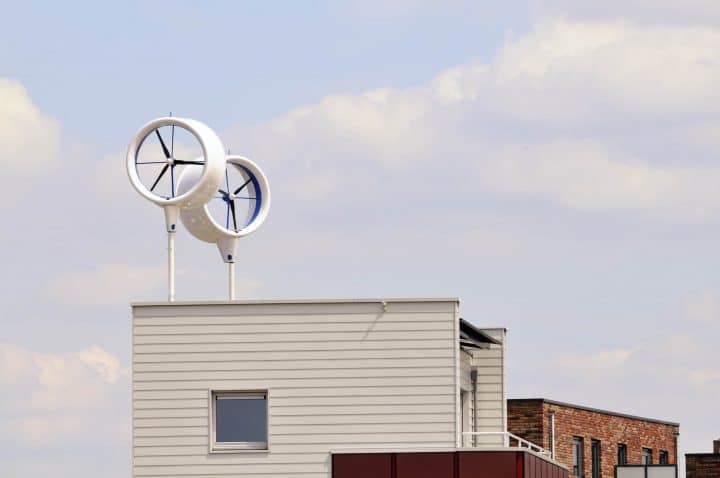How much energy a wind turbine produces can vary depending on a range of factors. The output of a turbine can vary depending on its size, placement and average wind speed over time. This article explores the topic of wind turbine capacity and how much power they can generate in different scenarios.
Power Output of Different Types of Wind Turbines
Let’s start by exploring how much energy different types of wind turbines can produce. The maximum amount of power will vary depending on various conditions such as how fast the wind is blowing.
Large Wind Turbines
Large wind turbines are used by utility companies for renewable power production. They are often found in clusters known as wind farms. These can be onshore or offshore but generally speaking, offshore locations have higher wind speeds. Wind projects of this scale result in the largest amount of energy production.

The world’s largest wind turbine is the Haliade-X 12 MW offshore turbine from General Electric (GE). This has the potential to generate 67 GWh of wind power each year – enough to power around 16,000 homes. The company estimates that using the Haliade-X in a 750 MW wind farm could power up to 1 million homes. You can take a look at GE’s promotional video below.
The closest competitor to the Haliade-X is the V174-9.5 MW turbine from MHI Vestas Offshore Wind. This turbine can power around 9,000 homes and is a variant of their previous record-breaking turbine, the V164-9.5MW.
The V174-9.5 MW turbine features several enhancements to boost power output including a larger rotor size. The company has announced a more powerful turbine, the V164-10.0 MW which is available for installation from 2021.
Residential Wind Turbines
Residential turbines are an option for those looking to tap into the power of the wind. Such turbines tend to start from around 1 kW, going up to 10 kW. Most homes are better off with at least 2 kW rated power output, depending on their power requirements.

A mid-ranged domestic turbine of 5 kW can provide around 8,000 kWh to 9,000 kWh of energy per year under the right conditions. Smaller turbines of around 2 kW can have an electricity generation of up to 3,000 kWh. Larger residential turbines have the potential to reach 15,000 kWh.
Some domestic turbines can reach over 15 kW however these tend to be much larger than those up to 10 kW. As a result, they are more suited to farms and large private estates.
The above data shows the estimated annual energy capacity in kWh at a wind speed of 5m/s. This will, of course, vary depending on the type of wind turbine, where you live and many other environmental factors. To get accurate figures, you should always consult a qualified domestic wind turbine installer who can carry out a feasibility assessment for your area.
These facts and figures are based on data from the UK’s Energy Saving Trust. Their guide to choosing a wind turbine offers an insight into how rated power output will vary depending on wind speed.
Portable Wind Turbines
Portable wind turbines are an option for those who require power on the move. These are popular amongst campers and recreational vehicle owners and can produce up to 600 W of wind energy.
Factors Affecting How Much Energy Wind Turbines Produce
There are many factors that dictate how much power a wind turbine will actually generate. Some of these include the following:
- Average Wind Speeds – This is key in determining how much energy a turbine will produce. Locations with higher average wind speeds are more suitable for wind energy than locations with low average wind speeds.
- Obstructions – If a wind turbine is built close to tall buildings, hills, or other obstacles, its efficiency can drop. Any obstruction has the potential to absorb and deflect wind energy away from the blades of a turbine.
- Altitude – Average wind speeds increase with altitude. At higher altitudes there is less friction to affect wind speeds. This is one of the main reasons why onshore wind farms are better placed on hills.
- Turbine Height – Taller wind turbines have a higher altitude and are less affected by obstacles on the ground. They also tend to have much longer blades, able to absorb even more wind energy.
- Turbine Design – Some turbines feature a yaw mechanism. This works in conjunction with a wind direction sensor and turns the head to face the wind.
- Blade Design – Blades that are aerodynamic will have less drag and turn more easily. As a result, aerodynamic blades produce more energy at lower wind speeds.
Which Countries Produce The Most Wind Energy?
The main producers of wind energy are China, the United States, and Germany. This is followed by India, Spain, and the United Kingdom, all of which have respectable capacities.
In 2018, China had a wind power capacity of 184,696 MW. Compare this to the USA who had a capacity of 94,295 MW and you will notice how China is well ahead in the rankings.
For the same period, Germany had a capacity of 59,420 MW, followed by India on 35,288 MW, Spain on 23,436 MW, and the UK on 21,736 MW. This data is according to a 2019 report by The International Renewable Energy Agency (IRENA).
We have an article that explores this topic in further detail. It provides a breakdown of the top 10 wind energy producers at the end of 2018.
Overview
Wind turbines produce varying amounts of energy depending on a wide range of factors. Some of the largest wind turbines can produce up to 12 MW of electricity. This is enough to power to around 16,000 households per turbine each year.
A good residential wind turbine should have a rated power output of between 2 kW and 10 kW. Turbines of this size have the potential to achieve electricity production of around 3,000 kWh to 15,000 kWh per year under the right conditions.
If you are considering wind energy for your home or business you should always consult a professional. Reputable companies will carry out wind speed assessments to give you an idea of how much energy your chosen wind turbine could produce.
As we produce more energy from the wind, we help to curb our carbon emissions. Such emissions are bad for our health and our planet. They can exacerbate respiratory illnesses and contribute to climate change. This is a key drawback of traditional power plants that use coal, oil, and gas.